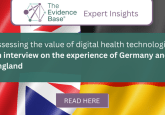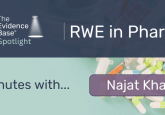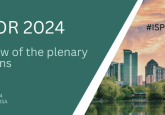RWE in Pharma: 5 minutes with… Helene Karcher

In this ‘RWE in Pharma’ interview series, we are putting various pharma experts in the spotlight and asking them to share their insight on how their industry has traditionally employed real-world evidence (RWE), how they envision this changing over the next few years, and what their predictions of the impacts of the highly anticipated U.S. FDA RWE Framework may be.
This installment features Helene Karcher, Global Head of the Real-World Evidence for Ophthalmology, Respiratory and Allergy department at Novartis.
 Please could you introduce yourself, your organization(s) and tell us more about your role?
Please could you introduce yourself, your organization(s) and tell us more about your role?
I am a Switzerland-based physicist, turned computer biologist, turned epidemiologist and patient access strategist. I started my career in pharma at Novartis over 15 years ago in translational medicine. I then returned to Europe and joined the founders of a new consultancy business in market access, health economics and epidemiology. We grew the business into an organization of over 200 people, which we sold in 2018. After a stint in London to lead the global HEOR function at Parexel, I rejoined Novartis 18 months ago.
My present role is to head the global real-world evidence (RWE) teams in ophthalmology, respiratory and allergy. My teams are responsible for setting up the strategy on RWE generation in these disease areas and to ensure the proper design and implementation of our real-world studies in these therapeutic areas worldwide.
Over the last 9 years, I have focused on patient access and epidemiology and worked with a wide range of RWD types and methods. My overall goal is to leverage appropriate data and quantitative methods to impact decisions in health care. I am also Editor in Chief of the Epidemiologic Methods journal and the elected Chair of the Statistical Methods in HEOR special interest group at ISPOR.
 What are the main ways real-world data (RWD) and RWE have traditionally been – and are currently – used by pharma?
What are the main ways real-world data (RWD) and RWE have traditionally been – and are currently – used by pharma?
In the past, RWD in the pharma industry came exclusively from prospective Phase 4 observational studies. These studies were designed to monitor safety – pharmacovigilance – and, more rarely, to generate comparative effectiveness to compare therapies in a particular real-world setting. We have shown in the past decade that the utilization of RWD can be much broader, from supporting selection of the best indication and target population early in drug development to anticipating much wider types of effects in a variety of clinical settings. We now use RWD to predict wider economic outcomes or gauge and optimize the feasibility of clinical trials.
At present, RWD is more widely accepted on an institutional level both in internal decision-making and regulatory and access approvals. The latest example is the recent FDA approval of alpelisib, based solely on RWD without clinical trial data. Supervisory bodies such as the FDA and NICE now offer guidance on how RWD should be utilized in submissions. This is a trend that highlights the evolution and increased acceptance of RWD and RWE.
 Do you think trust in RWE is increasing? What steps need to be taken to build this?
Do you think trust in RWE is increasing? What steps need to be taken to build this?
Yes, trust is increasing. The main issue hindering the trust of results coming from RWE studies has been the lack of knowledge and guidelines. In fact, the lack of guidelines fostered a lack of clarity and these shades of uncertainty have traditionally turned away many stakeholders. The steps to build trust and wider acceptance are the creation of recognized frameworks, which has been undertaken by a number of health authorities and scientific associations, and their dissemination. Teaching and disseminating the ground principles of epidemiology to larger audiences is the area that most needs reinforcement.
The rapid development of analytical tools and visualization techniques is a factor that increases trust, as is access to high quality RWD. The quality of the data and analyses is a fundamental component in the trust of RWE. Improved data capture and infrastructure should act as tailwinds to the overall trust-building process.
 How do you see pharma’s use of RWD/E changing over the next 5 years?
How do you see pharma’s use of RWD/E changing over the next 5 years?
Pharma will use RWD for all decisions from research, including target selection, to commercialization. Quickly identifying or building the necessary real-world dataset for each decision is a challenge that we need to overcome, but this should naturally improve as processes are standardized and as data collection methods and analytics tools continue to mature.
In addition, the recognition of the value of data and the improvement of processing technologies are macro-trends that coincide with another area of growth specific to pharma: patient-generated data. The convergence of these two areas is a significant development and sets the pharma industry up to reap the rewards of more, and higher quality, data and technology. This could take the form of speed of entry, time to market, improved regulatory environment and overall innovation.
 How do you think the COVID-19 pandemic has affected this trajectory and view of the value and usability of RWE/RWD?
How do you think the COVID-19 pandemic has affected this trajectory and view of the value and usability of RWE/RWD?
The COVID-19 pandemic has tremendously helped with the acceptance of RWD. As most traditional clinical trials were delayed by patients not being able to visit their doctors in person, their RWD or other RWD have been the only means available for studying these interactions. This is significant in several ways, one being as an accelerator of remote patient treatment and the acceptance of technology alongside human care. As a consequence, both RWD and RWE have become more deeply embedded in patient care at a rate far faster than would have been possible without the COVID-19 pandemic.
Regarding COVID-19 itself, treatment of ill people and the management of the pandemic on the societal level have been greatly improved through RWD/E, namely in identifying the best care strategies for COVID-infected patients and controlling and understanding the disease spread.
 What global implications do you think the recently released FDA RWE guidance documents will have on pharma’s use of RWE?
What global implications do you think the recently released FDA RWE guidance documents will have on pharma’s use of RWE?
The FDA RWE guidance documents have been years in the making and incorporate input from a wide range of stakeholders – we have been giving input since the conceptual days of these documents. Essentially, the FDA seeks to promote RWE utilization for regulatory submissions by explicitly saying that it is possible to submit RWD to garner new drug approval and by giving these data a frame. In doing so, the FDA is acknowledging RWD as meaningful evidence and this will have an impact beyond RWD for regulatory decisions. As such, this represents a significant shift in how the FDA has historically considered the role of regulation and increases the profile and acceptance of RWE.
Disclaimers:
– Novartis employee and shareholder, 2020–present.
– Editor-in-Chief, Epidemiologic Methods, 2019–present.
The opinions expressed in this feature are those of the interviewee/author and do not necessarily reflect the views of The Evidence Base® or Future Science Group.






